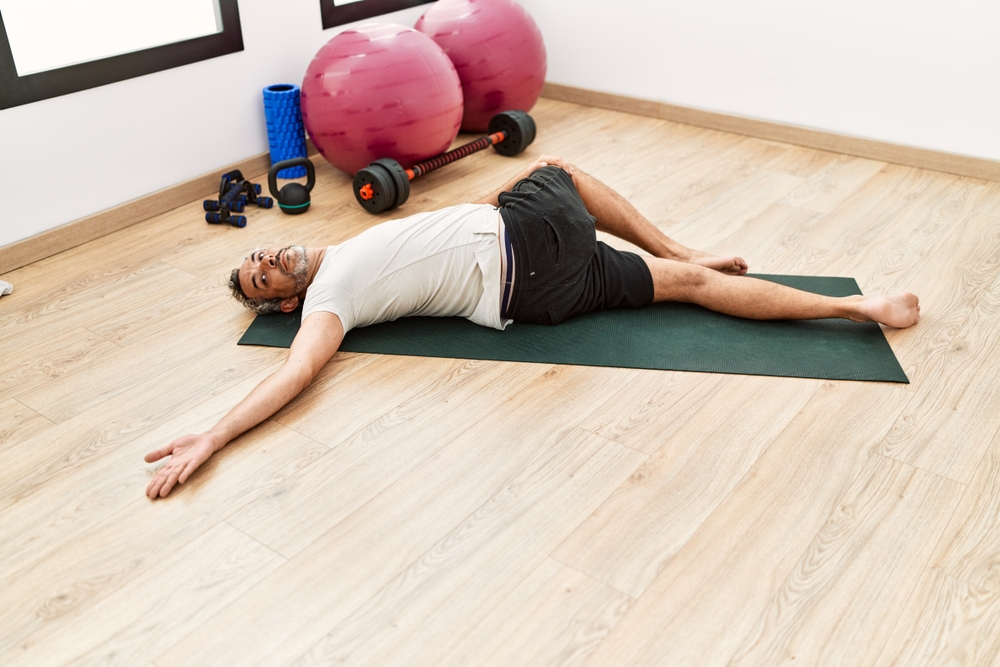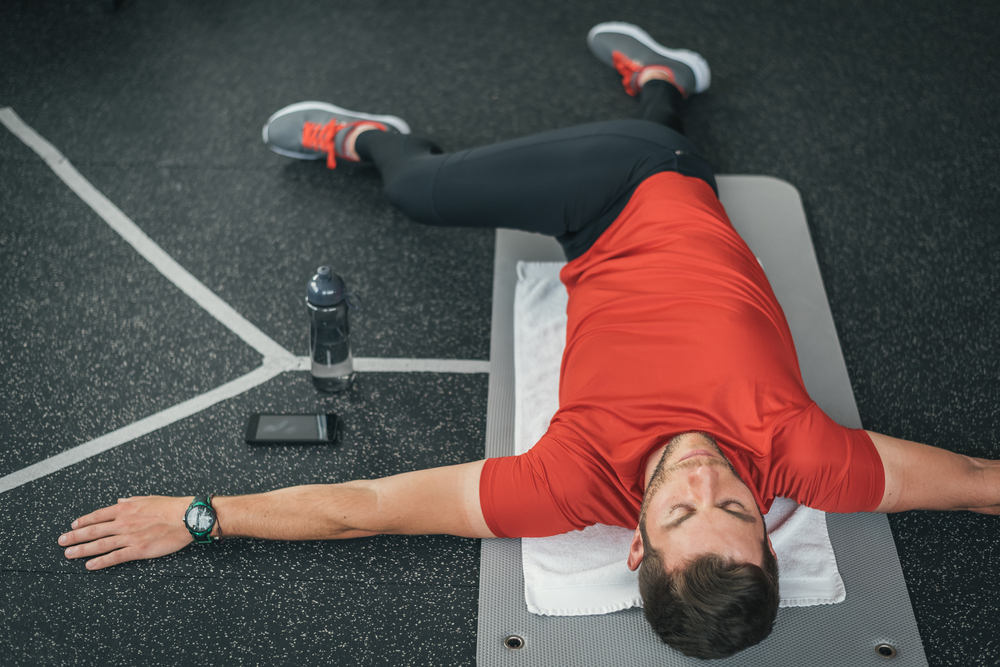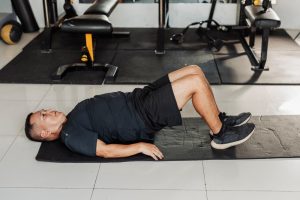The Open Book Stretch is a simple, equipment-free movement that helps improve spinal mobility, ease upper back and shoulder tension, and support better posture—especially if you spend long hours sitting.
You’ll lie on your side and rotate your upper body open, like turning a page in a book.
Keep reading for a step-by-step guide, benefits, variations, and tips to get the most out of it.
What Is the Open Book Stretch and What Does It Target?
The Open Book Stretch is a go-to movement for improving how well your upper back, chest, and shoulders move and feel—especially if you’re dealing with stiffness from sitting too much.
It’s simple to do, doesn’t require equipment, and is widely used in both clinical and fitness settings for good reason.
At its core, the Open Book Stretch is a gentle, lying-down rotation drill.
You start on your side and rotate your upper body open, as if turning a page in a book—hence the name.
Some also call it the “Book Opener” or “Book Opening.”
The goal is to move through your thoracic spine (the mid-to-upper part of your back) while keeping your hips stable.
This encourages your spine to rotate where it’s meant to—rather than compensating through your lower back or shoulders.
This movement is a staple in physical therapy clinics, Pilates classes, and post-rehab routines.
It’s particularly helpful for people who spend long hours at a desk or in front of a screen.
Over time, a sedentary posture tends to lock up the thoracic spine and tighten the chest, limiting your ability to move well—and often causing discomfort in places like your neck, shoulders, or lower back.
When done regularly, the Open Book Stretch helps:
- Improve thoracic spine mobility – freeing up the upper back to rotate and extend more naturally
- Increase shoulder and chest flexibility – by gently opening tight front-body tissues that get shortened with poor posture
- Support better posture – encouraging upright alignment without forcing it
- Relieve upper body tension – which often builds up silently from hours of slouching
- Expand the ribcage and improve breathing mechanics – helping you engage in deeper, more relaxed breathing
What sets this movement apart is how accessible it is. It’s low-impact, beginner-friendly, and doesn’t require any gear—making it ideal whether you're warming up, cooling down, or just trying to undo the effects of a long day at your desk.
Why the Open Book Stretch Works (and Who Should Use It)
The Open Book Stretch is more than just a feel-good movement—it’s a targeted way to restore mobility where many people need it most: the upper and mid-back.
If you spend long hours sitting, deal with postural tightness, or want to support healthy movement patterns, this stretch is worth adding to your routine.
One of the primary benefits of the Open Book Stretch is how it improves thoracic rotation—something most people lack without realizing it.
Limited movement in this part of the spine doesn’t just affect how your back feels; it often forces other areas like the neck or lower back to pick up the slack.
That can lead to pain, stiffness, or even movement compensations over time.
This stretch directly targets that problem by teaching your upper back to rotate independently and more freely.
By improving motion through the thoracic spine, you naturally take pressure off areas that tend to become overworked.
A stiff mid-back often contributes to poor posture—rounded shoulders, a forward head position, and a compressed chest.
The Open Book Stretch works against those patterns, helping to open the front of the body, relieve upper-back tension, and support a more upright alignment without forcing it.
Another benefit often overlooked is how this stretch encourages better breathing mechanics.
As you rotate, your ribcage expands, making it easier to breathe into your diaphragm rather than shallowly through your chest.
When you sync the movement with slow, deep breaths, the stretch becomes not only physical but also calming—especially helpful if you’re dealing with stress or screen fatigue.
One of the best parts about this stretch is how accessible it is.
It’s gentle on the joints, doesn’t require any special equipment, and can be adjusted to suit a wide range of fitness levels. That makes it a great fit for:
- People who sit for extended periods, especially desk workers
- Anyone looking to improve posture or relieve tension in the upper body
- Beginners who need a mobility exercise that’s simple and easy to follow
- Individuals rehabbing from movement restrictions with guidance from a provider
That said, there are a few situations where you’ll want to proceed carefully.
If you’ve had recent surgery or injury involving the spine, shoulders, or chest, it’s a good idea to get medical clearance before trying this stretch.
The same goes for individuals managing osteoporosis—combining spinal flexion with rotation can increase fracture risk in certain cases, so modifying or avoiding the movement may be necessary under professional guidance.
Step-by-Step Guide: How to Perform the Open Book Stretch Safely
This stretch might look simple, but doing it with proper form makes a big difference in how effective and comfortable it feels.
Here’s how to perform the Open Book Stretch with control and intention—so you get the most benefit while keeping your body supported throughout the movement.
Start by lying on your side on a comfortable surface.
A yoga mat works well, but a folded towel or carpeted floor is fine too. Bend your knees to about 90 degrees and stack your legs one on top of the other.
Your hips should stay level throughout the movement, so placing a yoga block or rolled towel between your knees can help stabilize your lower body.
If your neck feels strained, try using a small pillow or folded towel under your head for extra support.
Extend both arms forward at shoulder height with your palms pressed together.
This is your starting position.
Some people find that keeping the top elbow slightly bent (rather than fully extending the arm) reduces shoulder strain and makes the movement feel smoother.
From there, take a slow inhale and begin sweeping your top arm upward and back in an arc, as if you’re opening a book.
Let your chest rotate open along with the movement, but keep your hips and legs firmly in place.
Your eyes should follow your moving hand to maintain alignment through your neck and upper spine.
This also encourages a more natural range of motion and helps prevent strain in the cervical area.
Stop rotating once you feel a gentle stretch across your chest or in the mid-to-upper back.
You don’t need to force your arm all the way to the floor—just go as far as your body comfortably allows without arching your lower back or twisting your hips.
Then, on a slow exhale, reverse the motion and return your arm to the starting position.
You can perform this as a flowing movement or hold the open position as a static stretch:
- For reps, do 5 to 10 slow, controlled repetitions on each side.
- For holds, stay in the open position for 20 to 30 seconds before returning to the start.
In terms of frequency:
- Flowing version: 2 sets of 10 reps per side works well as part of a warm-up or mid-day mobility session
- Static version: 3 to 4 sets of 30 to 60 seconds per side is ideal for deeper stretching and end-of-day release
Tips, Variations, and Common Mistakes to Watch For

Getting the most out of the Open Book Stretch isn’t just about doing the movement—it’s about doing it well.
Subtle adjustments in form, breath, and pacing can make the difference between a movement that feels therapeutic and one that just ticks a box.
Whether you're brand new to the stretch or have been doing it for a while, the tips and variations below will help you refine your technique and avoid common pitfalls.
One of the most important things to watch for is where the movement is actually coming from.
A frequent mistake is allowing the arm to swing open without true spinal rotation.
When this happens, you miss the point of the stretch entirely. Instead, think of the motion originating from your upper back and ribs—not your shoulder joint.
Your arm is simply along for the ride.
Another area to pay close attention to is your lower back.
If your lumbar spine begins to arch or lift off the floor, you’re likely losing control of your hips.
To stay grounded, try gently tucking your hips or using a yoga block between your knees.
This helps keep the stretch concentrated where it should be—your thoracic spine.
Neck alignment also plays a big role.
Your head should follow your hand as it moves, which helps maintain a natural curve through your spine and prevents unnecessary strain in the neck.
If you’re looking straight ahead or letting your head lag behind, you're likely limiting the stretch and potentially inviting tension.
Pacing matters too. Rushing through reps or holding your breath can quickly turn a restorative movement into something less effective—and less safe.
Instead, move slowly and match each part of the motion with your breath.
Inhale as you open, exhale as you return. This rhythm not only improves control but also engages your core and calms your nervous system.
As for variations, there are a few worth exploring based on your needs and environment.
If shoulder discomfort is an issue, try a bent-elbow version, where the top arm stays bent throughout the movement.
This reduces the range needed from the shoulder and still gives you a quality spinal rotation.
For a seated alternative, the bow-and-arrow variation allows you to mimic the motion while sitting in a chair, making it ideal for desk breaks.
If you want to emphasize lower spine rotation instead, supine windshield wipers (lying on your back and dropping your knees side to side) can offer a good complement to the Open Book.
Beginner comfort also matters.
A small pillow under your head can support the neck, especially if lying flat causes discomfort.
And if you're new to mobility work, don’t worry about how far your arm goes—focus more on control, breath, and how the movement feels than on hitting a specific position.
Finally, listen to your body. You should feel a gentle stretch, not pain or strain.
If something feels off, adjust your setup or range of motion.
Small tweaks often go a long way in making this stretch not only more effective, but more enjoyable.
How to Fit It Into Your Routine (and What to Pair It With)
The beauty of the Open Book Stretch is that it fits into just about any part of your day.
It doesn’t require special equipment, it only takes a few minutes, and it pairs well with both movement prep and recovery.
Whether you’re easing into the day, unwinding after a workout, or just trying to break up a long session at your desk, this stretch earns its place.
You can easily build it into your morning or evening mobility routine to loosen up after sleep or wind down before bed.
In the morning, it helps wake up the spine and restore range of motion that may feel restricted after lying still.
In the evening, especially after a long day of sitting or working on a computer, it can help reverse postural tension and promote more relaxed breathing before sleep.
It’s also a great go-to for mid-day desk breaks.
If you’ve been sitting for more than an hour, your thoracic spine is likely starting to stiffen up—and your shoulders may be rounding forward.
Just a few slow reps of the Open Book Stretch can interrupt that pattern, helping you return to work feeling more mobile and mentally refreshed.
For those who train regularly, the Open Book Stretch fits well on either end of a workout.
Before training, include it as part of your warm-up to prepare your spine for rotational or overhead movements, especially if your workout involves lifting, rowing, or throwing.
Afterward, it works well in a cool-down to gently restore your posture and prevent stiffness from setting in.
If you want to track your progress, pay attention to how close your top arm gets to the floor over time.
Improved mobility will often show up gradually in that range.
But it’s not just about flexibility—once your rotation improves, it’s smart to build strength in that new range.
You can do this by pairing the Open Book with rotational strength exercises, like standing band or cable rotations.
These add resistance to the same movement patterns, helping you not only move better but also control that movement under load.
Ultimately, the goal is to improve both flexibility and functional control through your upper spine.
Use the Open Book Stretch regularly, listen to how your body responds, and over time you’ll likely find your posture, breathing, and overall comfort improving—even if the rest of your routine stays the same.
When to Use Caution (And Who Should Talk to a Doctor First)
While the Open Book Stretch is generally safe and beginner-friendly, there are a few situations where caution is important.
Like any movement, it’s most effective when it’s appropriate for your body and your current health status.
If you’re recovering from an injury or managing a medical condition, it’s worth checking in with a healthcare provider before adding this to your routine.
If you’ve recently had surgery or are still recovering from an injury involving the spine, shoulder, or chest, it’s best to get medical clearance first.
These areas are directly involved in the motion of the Open Book Stretch, and rotating too early or too far during recovery can potentially delay healing or aggravate symptoms.
People with osteoporosis also need to be especially careful.
Combining spinal flexion and rotation—common in some variations or when form isn’t controlled—can increase the risk of compression fractures in individuals with low bone density.
If you fall into this group, talk to your doctor or physical therapist about whether the Open Book is safe for you, and how it might be modified to minimize risk.
Even for people without known conditions, it’s important to listen to your body.
The stretch should feel like a gentle opening through your chest and upper back—not like something you have to push through.
If you experience sharp pain, tingling, or discomfort that doesn’t resolve when you back off the range of motion, stop immediately. That’s your body signaling that something’s off.
There’s also a difference between stretching into mild resistance and forcing a range you don’t yet have.
You should feel a controlled stretch, not an intense pull or strain.
Try adjusting your position, using props for support, or shortening the range until it feels accessible and relaxed.
When in doubt, a qualified physical therapist or rehab professional can assess your needs and suggest alternatives or modifications.
They can also help ensure you’re moving from the right places in your body and getting the benefits you’re after—without compromising safety.
Conclusion
The Open Book Stretch is a simple yet powerful way to improve upper body mobility, reduce tension, and support better posture—especially if you sit often.
It’s easy to fit into any routine and can be adjusted to match your comfort level and needs.
With consistent practice and proper form, you’ll move, breathe, and feel better throughout the day.







